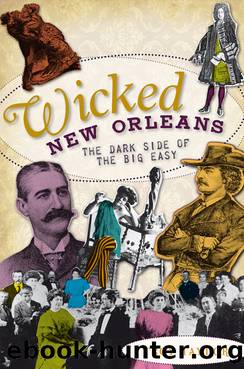Wicked New Orleans by Troy Taylor

Author:Troy Taylor
Language: eng
Format: epub
Tags: Wicked New Orleans
ISBN: 9781614230113
Publisher: Arcadia Publishing
Published: 2011-04-28T00:00:00+00:00
Concert saloons offered entertainment to the drinkers who were expected to buy drinks from the âbeer jerkers,â who also worked as prostitutes in the establishments. Men who drank too much could usually expect to be robbed.
The St. Nicholas was the first concert saloon to open in New Orleans, but it was followed by the Napoleon, the Bismarck, the Pavilion, the Gem, the Royal Palace Beer Saloon & Concert Hall, the Conclave, the Buffalo Bill House and Wengerâs Garden on Bourbon Street, which in 1869 proudly summoned patrons to inspect a novelty that was advertised as âthe remarkable machine known as the self-acting organ.â
Other such establishments had their own claims to fame. At the Conclave, it was the garish decorations; the âwine-room,â where aerated cider was sold as champagne; the life-size portrait of Don Quixote in the entrance lobby; and the spectacle of the proprietor, dressed as Cervanteâs character, lurking about the place keeping order with a large wooden club. The Conclave was one of the few places to keep a bar in addition to table service, and the arrangement of the bar back created quite a disturbance in the city. It was an exact replica of the burial vaults, or ovens, which spanned a wall of St. Louis Cemetery No. 1. The marble slabs, instead of bearing the names of the dead, were chiseled with âbrandy, whiskey, gin, etc.â The bartenders were dressed as undertakers, and when one of them served a customer, he opened a vault in the bar and pulled out a small, silver-handled casket lined with bottles of the liquor the patron ordered. The Conclave was a popular drinking spot for the tourist crowd, but it never really caught on with the dedicated drinkers.
The Royal Palace Beer Saloon & Concert Hall was operated by Otto Henry Schoenhausen. He opened the resort in 1867, but it was closed down two years later when Schoenhausen went to prison for the murder of Dr. H.L. Nelson in a Canal Street confectionary. He was pardoned by the governor in 1882 and came out of the penitentiary with $10,000, which he had acquired by lending money to the guards at high interest rates. He immediately reopened the Royal Palace, and for the next seven or eight years it was one of the most popularâand disreputableâresorts in the city. Schoenhausen employed about twenty waiter girls, some of whom also sang and danced, and sold beer for five cents a glass and forty cents a bottle.
The Buffalo Bill House was kept by a scruffy, bearded ruffian named Bison Williams, who came to New Orleans from Cincinnati in the latter part of 1862 and ran a lunchroom on St. Charles Avenue until the end of the Civil War. He then opened his combination concert saloon and dance house and installed a staff of leg-breakers and prostitutes to handle and service his customers. He scorned the âart poses by living modelsâ that were popular at other such resorts and instead offered his patrons bare-knuckle boxing, head-butting contests, wrestling matches and rat and dog fights.
Download
This site does not store any files on its server. We only index and link to content provided by other sites. Please contact the content providers to delete copyright contents if any and email us, we'll remove relevant links or contents immediately.
| African Americans | Civil War |
| Colonial Period | Immigrants |
| Revolution & Founding | State & Local |
Cat's cradle by Kurt Vonnegut(15108)
Pimp by Iceberg Slim(14230)
4 3 2 1: A Novel by Paul Auster(12231)
Underground: A Human History of the Worlds Beneath Our Feet by Will Hunt(11986)
The Radium Girls by Kate Moore(11873)
Wiseguy by Nicholas Pileggi(5618)
Perfect Rhythm by Jae(5282)
American History Stories, Volume III (Yesterday's Classics) by Pratt Mara L(5217)
The Fire Next Time by James Baldwin(5205)
Paper Towns by Green John(5030)
Pale Blue Dot by Carl Sagan(4865)
A Higher Loyalty: Truth, Lies, and Leadership by James Comey(4803)
The Mayflower and the Pilgrims' New World by Nathaniel Philbrick(4383)
The Doomsday Machine by Daniel Ellsberg(4380)
Killers of the Flower Moon: The Osage Murders and the Birth of the FBI by David Grann(4353)
The Sympathizer by Viet Thanh Nguyen(4267)
Too Much and Not the Mood by Durga Chew-Bose(4235)
The Borden Murders by Sarah Miller(4195)
Sticky Fingers by Joe Hagan(4071)
